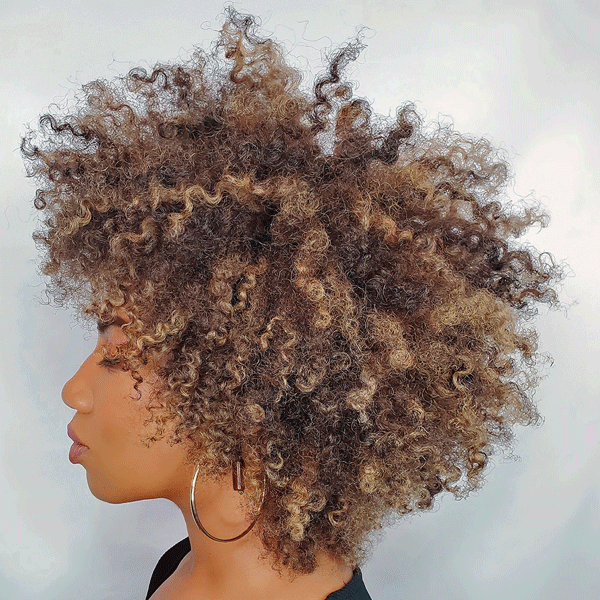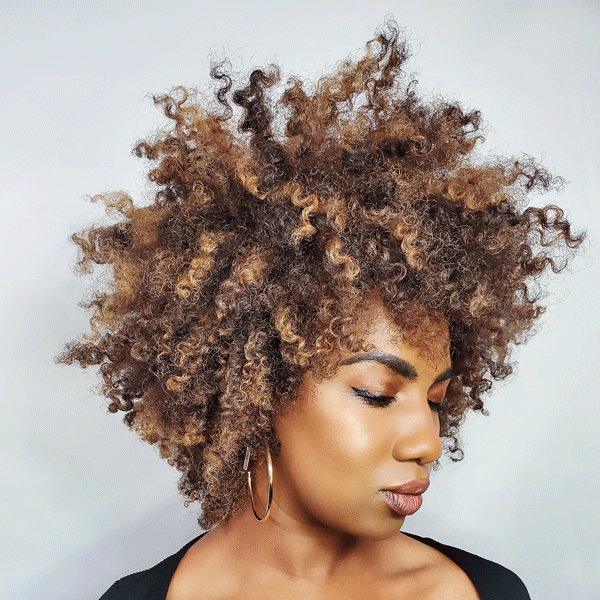How-To: Transform Curly & Textured Hair In One Highlight Service
Textured Hair Education: Haircolor Placement For Maximum Impact
Have a textured-hair client looking for a total transformation but you don’t know where to begin? Look no further than BTC University. We had textured hair expert Kara Williams (@haircolorkilla) teach her signature technique for giving curly clients root coverage, highlights AND lowlights efficiently and safely. Click here to purchase Kara’s course on BTC-U, then keep scrolling for everything you will learn!
Takeaway Tips:
You can learn Kara’s full technique in her 90-minute course, but we’re teasing these tips you need to know now!
Tip #1: Level Down To Avoid Warmth
Since her client has a darker starting level, Kara formulates a cool root color with a lower developer to avoid hot root. Since she is applying the root color first, she always formulates the base a full to half level darker with a lower developer since it will sit the longest. Then, in order to create a seamless blend throughout, she bumps the developer in the lowlight formula. Want the full formula breakdown? Keep scrolling!
Tip #2: Section For Softness
Kara’s goal is to create a softer gradient around the client’s face and gradual dimension in the back. To achieve this, she uses diagonal forward sections at the hairline and horizontal sections through the interior.
Pro Tip: Want to learn the difference between diagonal back and diagonal forward partings? Kara advises to pay attention to the way the hair falls. “If you’re unsure about which is which, create the part and see where the hair lays naturally. If it falls forward, like for a front money piece, then the section is diagonal forward. If it falls back, it’s a diagonal back section,” she explains.
Tip #3: When It Comes To Placement, Always Plan For More
Textured hair, unlike straight hair, does not reflect light, it actually absorbs light. So, in order to give textured clients maximum brightness, Kara advises to place more highlights than you would for a straight-haired client. For example, if your client is asking for their highlights to be split equally (50 percent dark and 50 percent highlight), you would have to place about 75 percent highlight so this way when their hair is curly it will actually appear to be evenly split.
Slide To Check Out The Gorgeous Before & After!

Have Questions? Kara Has Answers!
One of the benefits of watching a course on BTC University? Artists are able to answer your questions in REAL TIME! Here are some technical questions viewers had for Kara during her livestream:
Question: How do you adjust your technique and formulas for clients that use a relaxer in their hair?
Answer: “What I tell my clients in the salon is, ‘You’re dealing with chemicals, and hair can honestly only handle one chemical at a time. So, if you are relaxing your hair, then bleaching and coloring is probably not your best bet.’ If the client is natural, then they have more options when it comes to color—but only if the hair is extremely healthy. And by extremely healthy I mean, there are no split ends, your porosity is even and your hair is strong and resilient. If that is the case, you have some options when it comes to color but I personally do not bleach relaxed hair and when using color I do not use anything above 20-volume developer.”
Q: What is your advice to fix or avoid over-toning?
A: “Textured hair is more fragile and more porous. So, in time that freshly colored hair can become so porous that as soon as you apply, for example, Level 10 lightener with all the clear in the world, it instantly turns gray. It is because the cuticle is so open that when toning, the hair just sucks it right up. To avoid that, I like to use the Extreme CAT Protein Reconstructing Hair Treatment Spray from Redken. It’s a spray so it does not clog the cuticle or manipulate the color but it does help even out the porosity, bring the pH down and help close the cuticle. So when you apply a toner it is an even deposit.”
Click On The Beaker Below For Kara’s Formula Deets!


Products Used
Click Here To Purchase Kara’s Class On BTC University And Have Unlimited Access To The Course!






